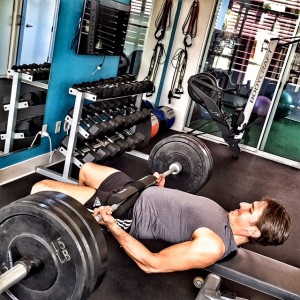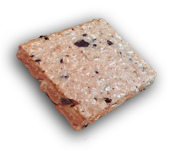 This blog was inspired by a lively debate I had with a good friend and avid lifter. He was going on about how sick and tired he is of seeing people doing weighted hip thrusts and how he didn’t feel that it was a worthwhile exercise. He claimed that if he wanted to develop his glutes further, he’d simply squad and deadlift more often. Conversely, I love the weighted hip thrust and argued that it definitely has its place in posterior chain development. That no other movement isolates the glutes the way the hip thrust does and that when done correctly, it is a very safe lift. In the end, he left unconvinced. I decided to delve deeper into the subject and spent a while going over research on the benefits of hip thrusts. What follows is a summation of my discovery.
This blog was inspired by a lively debate I had with a good friend and avid lifter. He was going on about how sick and tired he is of seeing people doing weighted hip thrusts and how he didn’t feel that it was a worthwhile exercise. He claimed that if he wanted to develop his glutes further, he’d simply squad and deadlift more often. Conversely, I love the weighted hip thrust and argued that it definitely has its place in posterior chain development. That no other movement isolates the glutes the way the hip thrust does and that when done correctly, it is a very safe lift. In the end, he left unconvinced. I decided to delve deeper into the subject and spent a while going over research on the benefits of hip thrusts. What follows is a summation of my discovery.
Research has shown that while both squats and deadlifts work the quads and hamstrings to maximum effect respectively, they do NOT maximize glute activation and hip extension, thus do not develop optimal glute growth or strength gains. Strength and conditioning guru and hip extension expert Bret Contreras equates the hip thrust to being like the bench press for the lower body: three points of support and the ability to work the hips horizontally, while not being limited by core stability or spinal extension strength. He also notes, that as a simple lift, it’s conducive to relatively fast progressive overload allowing for maximal gains. In fact, Bret has done several research papers that detail how the hip thrust out-performs squats and deadlifts in glute activation as well as allowing for a greater end range of hip extension. One of the major reasons is that the knees stay bent throughout the movement, releasing tension in the hamstrings, forcing the glutes to work harder to extend the hips.
Another factor that makes the hip thrust better than squats and deadlifts for glute development is that the hip thrust places glutes under duress for longer, resulting in less drop in torque toward end of the movements. At the top of the squat and deadlift, the glutes are basically resting, not so in the hip thrust. Thus, during hip thrusts the glutes experience greater time under tension, a key factor in both strength development and hypertrophy.
Another argument non believers love to make is that the hip thrust isn’t a “functional movement.” Well, the majority of people’s goals in the gym is to look better and get stronger, the hip thrust achieves both of these goals, thus it’s totally functional to their end goal. However, if you want to go to the exact idea of functionality, yes, a squat is more functional in relation activities that require knee strength (jumping for example), but many sporting activities also require hip stability, end range hip extension strength, torque glute strength, thus the gains achieved using hip thrusts, make it functional to achieve those goals.
In conclusion, the glutes, quads and hamstrings all work synergistically to produce maximal horizontal and vertical power, thus squats, deadlifts and hip thrusts should be used in combination to produce well-rounded strength, power and aesthetic muscular development.







